Aston Martin DB5
The Aston Martin DB5 is a British luxury grand tourer (GT) that was made by Aston Martin and designed by the Italian coachbuilder Carrozzeria Touring Superleggera.[3] Released in 1963, it was an evolution of the final series of DB4.
| Aston Martin DB5 | |
|---|---|
.jpg) | |
| Overview | |
| Manufacturer | Aston Martin |
| Production | 1963–1965 (1,059 units), 2020- (25 units)[1] |
| Designer | Carrozzeria Touring Superleggera |
| Body and chassis | |
| Class | Grand tourer |
| Body style | 2-door 2+2 coupé 2-door convertible (123) 2-door shooting brake (13)[2] |
| Layout | Front-engine, rear-wheel-drive |
| Doors | 2 |
| Powertrain | |
| Engine | DOHC Straight-6, 4.0 L (3,995 cc) |
| Power output | 282–325 bhp (210–242 kW) @ 5500 rpm 280–288 lb⋅ft (380–390 N⋅m) @ 4500 rpm |
| Transmission | 5-speed ZF box or optional BorgWarner 3-speed automatic |
| Dimensions | |
| Length | 4.57 metres (179.9 in) |
| Width | 1.68 metres (66.1 in) |
| Kerb weight | 3,311 lb (1,502 kg) |
| Chronology | |
| Predecessor | Aston Martin DB4 |
| Successor | Aston Martin DB6 |
Although not the first in the DB series, the DB5 is the best-known cinematic James Bond car, first appearing in the James Bond film Goldfinger (1964).[4]
Design
The principal differences between the DB4 Series V and the DB5 are the all-aluminium engine, enlarged from 3.7 L to 4.0 L; a new robust ZF five-speed transmission (except for some of the very first DB5s);[5] and three SU carburettors. This engine, producing 282 bhp (210 kW), which propelled the car to 145 mph (233 km/h), available on the Vantage (high powered) version of the DB4 since March 1962, became the standard Aston Martin power unit with the launch in September 1963 of the DB5.[6]
Standard equipment on the DB5 included reclining seats, wool pile carpets, electric windows, twin fuel tanks, chrome wire wheels, oil cooler, magnesium-alloy body built to superleggera patent technique, full leather trim in the cabin and even a fire extinguisher. All models have two doors and are of a 2+2 configuration. The boot (trunk) lids differed slightly between the DB4 mark 5 and the DB5.
Like the DB4, the DB5 used a live rear axle.[7] At the beginning, the original four-speed manual (with optional overdrive) was standard fitment, but it was soon dropped in favour of the ZF five-speed.[5] A three-speed Borg-Warner DG automatic transmission was available as well.[8] The automatic option was then changed to the Borg-Warner Model 8 shortly before the DB6 replaced the DB5.[6]
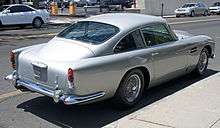
Specifications
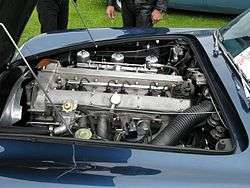
Standard coupé:
- Engine: 4.0 L (3,995 cc) Inline-6
- Bore x stroke: 96 mm × 92 mm (3.78 in × 3.62 in)
- Fuel feed: 3 SUs
- Power: 282 bhp (286 PS; 210 kW) at 5,500 rpm, 210 bhp (213 PS; 157 kW) Net
- Torque: 288 lb⋅ft (390 N⋅m) at 3,850 rpm
- Weight: 1,502 kg (3,311 lb)
- Top Speed: 145 mph (233 km/h)[9]
- 0–60 mph (97 km/h) Acceleration: 8 s.[9][10]
Variants
DB5 Vantage

The high-performance DB5 Vantage was introduced in 1964 featuring three SU model HD-8 side-draft carburetors and revised camshaft profiles, delivering greater top-end performance at the expense of overall flexibility, especially as legendary Webers are renowned as 'full-throttle' devices. This engine produced 325 bhp (330 PS; 242 kW) at 5,500 rpm.[10] 65 DB5 Vantage coupés were built.
DB5 convertible
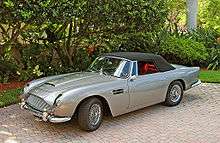
123 convertible DB5s were produced (also with bodies by Touring), though they did not use the typical "Volante" name until 1965.[5] The convertible model was offered from 1963 through to 1965. Originally only 19 of the 123 DB5 Convertibles made were left-hand drive. 12 cars were originally fitted with a factory Vantage engine, and at least one further convertible was subsequently factory fitted with a DB6 specification Vantage engine. A rare factory option (actually fitted by Works Service prior to customer delivery) was a steel removable hard top.
From October 1965 to October 1966, Aston Martin used the last 37 of the Aston Martin DB5 chassis' to make another convertible model. These 37 cars were known as "Short Chassis" Volantes and were the first Aston Martins to hold the "Volante" name. Although calling it a "Short Chassis" is a bit of a misnomer as the "short" comes from comparing it to the subsequent DB6, which has a longer chassis. When compared to the DB5, it is not "short" but rather the same size, however these cars differ to the DB5 convertible models as they feature DB6 split front and rear bumpers and rear TR4 lights, as also used on the DB6.
DB5 shooting-brake
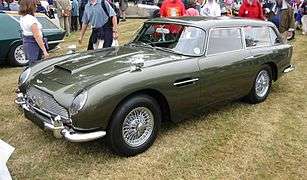
A prototype DB5 shooting-brake was custom produced by the factory for David Brown, an avid hunter and dog owner, and a further 11-12 coupés were custom modified for Aston Martin by independent coachbuilder, Harold Radford.[11][12] The taillights used were Triumph units, and were also adopted for the succeeding DB6. In August 2019 a DB5 sold for a record $1.765m (£1.456m) [13] making it the most valuable Shooting Brake bodied-car of any marque sold at auction.
James Bond's DB5
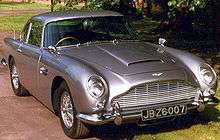
The Aston Martin DB5 is among the best-known cars in the world thanks to special effects expert John Stears, who modified the DB5 for use by James Bond in the film Goldfinger (1964). Although Ian Fleming had placed Bond in a DB Mark III in the novel, Stears persuaded the company to make its DB5 prototype available.[14]
To promote the film, the two DB5s were showcased at the 1964 New York World's Fair, and it was dubbed "the most famous car in the world",[15] and subsequently sales of the car rose.[16] In January 2006, one of these was auctioned in Arizona; the same car was originally bought in 1970 from the owner, Sir Anthony Bamford, by a Tennessee museum owner.[17] A car, mainly used for promoting the movie, is now located in the Louwman Museum, Netherlands.[18] The first DB5 prototype used in Goldfinger with the chassis number DP/216/1 was later stripped of its weaponry and gadgetry by Aston Martin and then resold. It was then retrofitted by subsequent owners with nonoriginal weaponry. It later appeared in the film The Cannonball Run (1981), in which it was driven by Roger Moore. The Chassis DP/216/1 DB5 was stolen in 1997 from its last owner in Florida and is currently still missing.[19]
Since the film, the DB5 has become closely associated with the James Bond franchise and is considered to be the quintessential vehicle of the character. As such, it has reappeared in subsequent films over the years. Within the universe of James Bond, the same car (registration BMT 216A) was used again in the following film, Thunderball, a year later.
A different Aston Martin DB5 (registration BMT 214A) was used in the 1995 Bond film GoldenEye, in which the car is Bond's personal vehicle and has no gadgets. Although it did come equipped with a champagne cooler in the arm rest and a fax machine. Three different DB5s were used for filming. This same car briefly reappeared in the next film, Tomorrow Never Dies (1997), and was set to make a cameo appearance in the Scotland-set scenes in The World Is Not Enough (1999), but most of the scenes were cut in the final edit. Yet another DB5 (registration 56526) appeared in Casino Royale (2006), this time owned by the villain, Alex Dimitrios. This car has Bahamian number plates and left-hand drive (where the previous British versions had been right-hand drive). In the film Bond wins the car from Dimitrios after beating him in a card game.
The Goldeneye DB5 currently resides at the London Film Museum in Covent Garden. Of the three cars used in the production, one car was filmed for the static ocean side shot, one's participation is unknown, and DB5/1885/R was driven in the chase scene against the Ferrari in Monte Carlo. DB5/1885/R was bought at a Christies auction in 2001 and entered the Guinness Book of Records that year for the highest paid for a Bond memorabilia. It was first exhibited at the Bond exhibition at Beaulieu before moving to its new home in The London Film Museum.
Another silver-birch DB5 with the original registration BMT 216A was used in the 23rd James Bond film, Skyfall, during the 50th anniversary of the release of the first James Bond film Dr. No (1962).[20] It is unclear if this car is meant to be the same one Bond won in Casino Royale, refitted with British number plates, right-hand drive, and gadgets. The car is destroyed in the film's climactic finale. It is seen again in Spectre (2015), firstly in Q's underground workshop in various stages of rebuild, and at the film's ending, fully rebuilt, with Bond driving away with it.
On 1 June 2010, RM Auctions announced the upcoming auction of a DB5 used in both Goldfinger and Thunderball. The owner (Jerry Lee, president/owner of WBEB Radio in Philadelphia, Pennsylvania) originally bought the car from the Aston Martin company in 1969. At the auction, the DB5 was sold for £2.6 million.[21] (£2.912m with commission) equates to $4.6m. In August 2019 a DB5 Bond car made to promote Thunderball sold for a record [13] $6,385,000 (£5,267,593).
Aston Martin announced in August 2018 that it plans to build 25 replicas of the DB5 as seen in Goldfinger, including some of the gadgets seen in the film, each selling for about GB£2.75 million.[22]
In 2019, it was confirmed by Aston Martin that the car would be featured in the next Bond film, No Time to Die, to be released in April 2020.[23] The plan was to build a replica, not use an existing vehicle. In fact, a full 25 were to be built, in partnership with Eon Productions, the Bond films producer. The Goldfinger DB5 cars were to have several functional spy gadgets, including smoke screen, oil slick, revolving license plates, machine guns (non-functional) and rear bullet shield.[24]
Promotional items
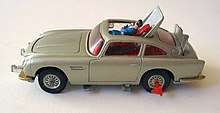
With Goldfinger, Corgi Toys began its decades-long relationship with the Bond franchise: they produced a toy of the car, which became the biggest selling toy of 1964.[25] A highly detailed 1:24 scale plastic kit was also produced by Airfix between 1966 and 1970.[26]
A highly detailed 1:24 scale die-cast model with many working features was produced as a limited edition in 2006 for Casino Royale, by the Danbury Mint. In January 2011 a 1/8 scale model was released by part work magazine publisher GE Fabbri in the UK. Over 85 weekly parts, the model builds into one of the biggest 007 scale models to date, with working gadgets and lights.[27] In 2015 Hotwheels Elite released their Cult Classics Goldfinger Aston Martin DB5 in 1/18 and 1/43 scale, the 1/18 model featured many of the gadgets from the original film.
In July 2018 Lego and Naomie Harris unveiled a 1:8 scale 1,290 piece set with bullet shield and ejector seat.[28][29]
In popular culture
Aside from its use in the Bond films, the DB5 also appeared in "The Noble Sportsman", a 1964 episode of The Saint TV series starring future Bond, Roger Moore. The car in question was the original Chassis DP/216/1 DB5, with the registration BMT 216A, used in Goldfinger. The episode was filmed before Goldfinger, when the car was still painted in its original dark red coat. The Chassis DP/216/1 DB5 also appeared in the film The Cannonball Run (1981), in which it was again driven by Moore (although he did not drive the car during his Bond tenure). In the film, Moore plays Seymour Goldfarb, Jr, a man who believes himself to be Roger Moore, who participates in a madcap, cross-country road race. Since its appearance in Goldfinger, the car had been stripped of its gadgets and re-registered as a regular road car. The car appears with its new registration number, 6633PP, and replica gadgets that were fitted to the car for the film.
The 1983 reunion telefilm The Return of the Man from U.N.C.L.E.: The Fifteen Years Later Affair includes a brief cameo by George Lazenby as "JB", a white-tuxedoed British man shown driving a DB5, who assists Napoleon Solo during a car chase. "It's just like On Her Majesty's Secret Service," enthuses a female character at the conclusion of the cameo. This special came out in 1983, the same year as Octopussy and Never Say Never Again were released.
It appears in several video games such as 007 Racing, Driver San Francisco (Deluxe Edition), James Bond 007: Agent Under Fire, From Russia with Love, and James Bond 007: Blood Stone. The film, From Russia with Love was released in 1963, one year before Goldfinger (in which the DB5 was first used), but the video game used the car.
It appeared in animated form in James Bond Jr. in the very first episode "The Beginning". In the episode it was able to transform into a plane and could be driven by remote control. The car was destroyed in a plane crash and was recycled into a red sports car, which the PAL VHS cover identifies as the "Aston Martin Super".
A version of the car appeared in Grand Theft Auto: London 1969, being called a "James Bomb".
Leonardo DiCaprio was seen driving the car in Catch Me If You Can (2002) imitating Bond (even down to the suit) in Goldfinger, during a scene which takes place the year the film was released. It also appeared in the action comedy film Charlie's Angels: Full Throttle (2003), driven by Bernie Mac's character, Jimmy Bosley. It is only seen once in which Bosley is driving a witness, Max Petroni (portrayed by Shia LaBeouf) to his mother's house, to be safe from the O'Grady Crime Syndicate.
The French spy comedy film, Double Zéro (2004) directed by Gérard Pirès also featured a DB5. It can be seen once in the film, when the two main characters go to meet the parody of Q.
An Aston Martin DB5 appeared in heavily stylized form as "Finn McMissile", a British secret agent voiced by Michael Caine in the Pixar film Cars 2 (2011). The car character was a homage to the Bond DB5, although it also bore a resemblance to the Volvo P1800, as used by the fictional British secret agent Simon Templar in The Saint television series.
The car appeared in Chitty Chitty Bang Bang Flies Again, a sequel to Fleming's novel by Frank Cottrell-Boyce, which was published in 2011. In the book, it is heavily implied that the car had belonged to James Bond.
In 2013, Grand Theft Auto V featured a car called the "JB 700" that is based on the DB5; In the game's story mode, the player must steal one equipped with numerous gadgets – including caltrops and functional machine guns mounted to the car's front wings – from a film set.
Need for Speed: Most Wanted released a DLC named "Movie Legends" that featured the car.
The music video for the Usher song "Burn" features a DB5. The same car with the same registration number appears a number of times in the short lived TV series Fastlane.
In the 2015 TV series Thunderbirds Are Go a DB5 can be seen as Lady Penelope gets into Fab 1 in the first episode "Ring Of Fire".
The DB5 appears in yet another racing game entitled Forza Horizon 4 as part of the James Bond DLC pack. The gadgets used in Goldfinger can be seen in its showcase mode.
See also
References
- "Ikonisk filmbil återskapas!". Klassiker. Retrieved 2 June 2020.
- Cottingham, Tim (9 July 2008). "Aston Martin DB5 Shooting Brake by Harold Radford (1965–1967)". Aston Martins.com. Retrieved 7 October 2019.
- Eveleigh, Ian (16 December 2008). "Birth of an icon: 1963: Aston Martin DB5". Evo. Retrieved 24 April 2018.
- "Aston Martin DB5". MI6: The Home of James Bond 007. Archived from the original on 8 January 2009. Retrieved 27 January 2011.
- Flammang, James M. (1994). Standard Catalog of Imported Cars, 1946-1990. Iola, WI: Krause Publications. p. 57. ISBN 0-87341-158-7.
- "Used car test: 1964 Aston Martin DB5". Autocar. Vol. 129 no. 3777. 4 July 1968. pp. 46–47.
- "Style Icon – Aston Martin DB5". The Mitchelli. 3 April 2011. Retrieved 3 September 2015.
- Lawrence, Mike (1991). A to Z of Sports Cars. Bideford, Devon: Bay View Books. p. 36. ISBN 1-870979-81-8.
- "Road Test #1992: Aston Martin DB5" (PDF). Autocar. 18 September 1964. Archived from the original (PDF) on 16 October 2006 – via Works Torque, April 2006, p. 14.
- "1964 Aston Martin DB5 Vantage". Carfolio. Retrieved 9 July 2018.
- Hingston, Peter (2008). The Enthusiasts' Guide to Buying a Classic British Sports Car. ISBN 0-906555-25-6.
- Dowsey, David (2007). Aston Martin: Power, Beauty and Soul. Images Publishing. p. 101. ISBN 0-9578759-5-9.
- McLaren, Marc (16 August 2019). "Bond DB5 sets new world record at Monterey sale". Classic & Sports Car. Retrieved 7 October 2019.
- Vallance, Tom (19 July 1999). "Obituary: John Stears". The Independent. Retrieved 29 August 2018.
- Pfeiffer & Worrall (1998), p. 33.
- Bouzerau (2006), pp. 110–111.
- "James Bond car sold for over £1m". BBC News. 21 January 2006. Retrieved 25 April 2010.
- "Aston Martin DB5 (James Bond)". Louwman Museum. Retrieved 7 October 2019.
- "Classic Feature: 1965 Aston Martin DB5". Motor Trend. Retrieved 7 October 2019.
- "Image: DB5 in Skyfall". Yimg.com. Retrieved 3 September 2015.
- English, Andrew (28 October 2010). "James Bond Aston Martin DB5 sells for £2.6m". The Daily Telegraph. Retrieved 7 October 2019.
- Gitlan, Jonathan (20 August 2018). "Aston Martin will build 25 new Goldfinger cars—with gadgets". Ars Technica. Retrieved 20 August 2018.
- Chin, Chris (8 June 2019). "Aston Martin V8 Vantage Series II spotted during 'Bond 25' filming". Autoblog. Retrieved 7 October 2019.
- Woodard, Collin (15 May 2019). "The 7 Coolest Spy Gadgets on the Aston Martin DB5 Goldfinger Tribute Car". Motor Trend. Retrieved 7 October 2019.
- Pfeiffer & Worrall (1998), p. 43.
- Olins, Jay (31 December 2001). "Danbury Mint 1:24 1964 Aston Martin DB5 Saloon – James Bond, 007 Version (Discontinued)". DieCast.org. Retrieved 7 October 2019.
- "James Bond 007 Aston Martin DB5 - Build up 1:8 Aston Martin DB5 Replica". 007DB5.com. Retrieved 3 September 2012.
- "James Bond™ Aston Martin DB5 10262". Lego.com. Retrieved 7 October 2019.
- Wren, Wesley (18 July 2018). "Lego goes 'Goldfinger' with Bond's Aston Martin DB5". Autoweek. Retrieved 7 October 2019.
Sources
- Pfeiffer, Lee; Worrall, Dave (1998). The Essential Bond. London: Boxtree Ltd. ISBN 978-0-75222-477-0.CS1 maint: ref=harv (link)
- Bouzereau, Laurent (2006). The Art of Bond. London: Boxtree Ltd. ISBN 978-0-75221-551-8.CS1 maint: ref=harv (link)
External links
| Wikimedia Commons has media related to Aston Martin DB5. |
- "Aston Martin DB5". Objectbook. Archived from the original on 28 September 2007.
- "Aston Martin DB5". Internet Movie Cars Database.
- "An original sales brochure for the DB5" (PDF). Aston.co.uk. Archived from the original (PDF) on 4 September 2011.
- "Period DB5 sales literature and specification brochure" (PDF). Aston.co.uk. Archived from the original (PDF) on 4 September 2011.
- "Period original 1964 DB5 sales brochure" (PDF). Aston.co.uk. Archived from the original (PDF) on 4 September 2011.
- "1964 Aston Martin DB5 saloon/convertible full specification" (PDF). Aston.co.uk. Archived from the original (PDF) on 4 September 2011.
- "Full 1964 DB5 price list" (PDF). Aston.co.uk. Archived from the original (PDF) on 4 September 2011.